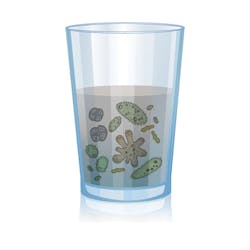Safe & Secure
About the author: Amy Reichel is marketing and communications specialist for the Water Quality Assn. Reichel can be reached at [email protected] or 630.505.0287.
Eight years ago, the drinking water treatment industry listened to consumers’ fears and concerns about emerging compounds in public and private water supplies. The industry took action and created a task force to develop a standard for endocrine-disrupting compounds (EDCs) and pharmaceutical and personal care products (PPCPs). Once it decided creating a standard for EDCs and PPCPs was feasible, it was moved to the standard Joint Committee, which is “the consensus body responsible for the development and revisions of NSF/ANSI standards” as defined by NSF Intl. The standard is now titled NSF/ANSI 401: Drinking Water Treatment Units – Emerging Compounds/Incidental Contaminants.
Through studies and surveying data, a list of 15 emerging compounds comprising pharmaceutical, personal care and endocrine-disrupting chemicals are the base of this standard. These compounds occurred with the highest frequency and/or at the highest levels of the compounds that were identified and studied. EDCs and PPCPs have not shown up in studies at levels that have raised health warnings from authorities, but consumers are concerned by their mere presence, despite these low levels.
Linda S. Birnbaum, Ph.D., DABT, ATS, director of the National Institute of Environmental Health Sciences, published a statement regarding EDCs: “Endocrine disruptors are naturally occurring or man-made substances that may mimic or interfere with the function of hormones in the body. Endocrine disruptors may turn on, shut off, or modify signals that hormones carry and thus affect the normal functions of tissues and organs.”
Birnbaum went on to explain the effects of being exposed to EDCs. “Subtle disruptions of endocrine signaling [are] a plausible mechanism by which chemical exposures at low doses can have effects on the body,” she wrote. These effects can be diseases and conditions, and they may last longer than the time a body is exposed to EDCs. Natural substances, such as arsenic and agricultural chemicals, commonly are found within the environment. Man-made substances are used in consumer products, such as water bottles, cosmetics and sunscreen, and may end up in the water system when they are washed off of a product or a person’s body.
PPCPs refer to products used by individuals for personal health or well-being for cosmetic purposes, as defined by the Water Quality Assn.’s (WQA) “Technical Fact Sheet: PPCP & EDC.” PPCPs also include products used for pets and livestock. Examples include medications for pain, depression and colds. Birth control pills, caffeine, hair products, cleaning supplies and pesticides also fall under the PPCP category. PPCPs can find their way into wastewater, surface water and groundwater supplies through human excrement, flushing unused or old medications in the toilet and washing chemicals down the drain. At this time, there are no confirmed adverse human health effects associated with PPCPs in drinking water. This does not reduce the amount of concern this topic has brought to the industry and consumers, however, and it continues to be a hot research topic.
Certifying Systems
NSF/ANSI 401 can help reduce consumer concerns about PPCPs and EDCs. Manufacturers of point-of-use and point-of-entry drinking water treatment systems designed to reduce specific emerging compounds/incidental contaminants can contact an American National Standards Institute (ANSI)-accredited, third-party certification body to get their systems certified to this standard. WQA, NSF and the International Association of Plumbing and Mechanical Officials offer NSF/ANSI 401 certification.
A product must go through the typical tests of a drinking water treatment system to achieve certification: performance testing, structural integrity testing and material safety testing. Structural and material safety testing are based on the testing requirements found in NSF/ANSI Standards 42, 53 and 58. Performance testing is based on the 15 substances listed in the standard: meprobamate, phenytoin, atenolol, carbamazepine, TCEP, TCPP, DEET, metolachlor, trimethoprim, ibuprofen, naproxen, estrone, bisphenol A, linuron and nonylphenol. The substances are at low, yet measurable, concentrations within the standard, but, again, are not at a concentration that is yet known to cause health concerns. At WQA, these substances are separated into testing groups, and manufacturers can choose to test any or all groups depending on the claims they would like to make for their systems. These groups are subject to change. Other certification bodies may split up the substances differently or not split them up at all.
Once a product goes through the testing and certification process, and passes all of the standard’s requirements, it will be listed on the certification body’s website as certified to NSF/ANSI 401 and will be able to use the appropriate certification logo. Certification to this standard will help consumers narrow down which systems meet their needs and protect them from emerging compounds that concern them.
EDCs and PPCPs have made their way to the forefront of the drinking water industry and consumer concerns. As a result of consumer wants and needs, the drinking water treatment industry has studied these compounds, and will continue to do so to make sure the levels found in drinking water do not place consumers at risk for health concerns. NSF/ANSI 401 helps give consumers a sense of security and safety while the industry continues to dive deeper into these emerging contaminants.
